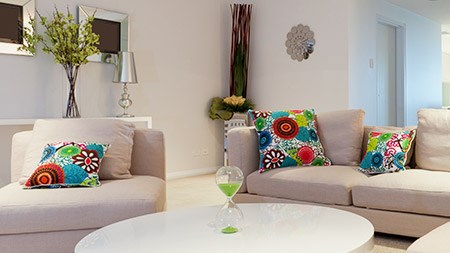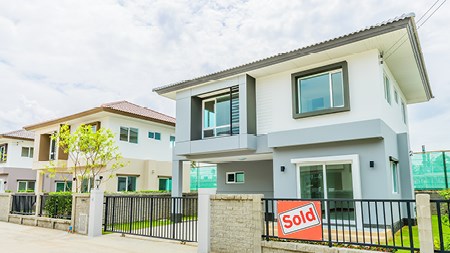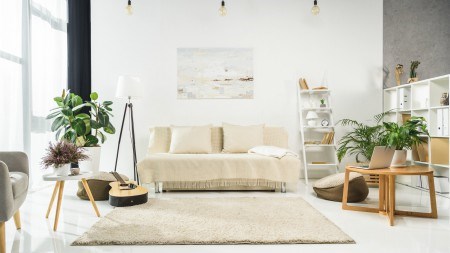Here are the 10 most important things you can do, to make sure you sell your home quickly, without having to drop your price.
A quick sale at close to the asking price has reached an almost mythical status. When we hear of it happening we put it down to luck, a once-off. And yet there are properties that are selling in the first week of being shown, without lingering for months, or the asking price being dropped. The secret ingredient? A home-staging professional.
Home-staging is still relatively new in South Africa, although it has been a mainstream part of the selling process in the UK and US for many years now. ‘If I mention what I do to an acquaintance, they say, “Oh yes, that’s about putting muffins in to bake and grinding coffee beans when the house is being viewed”,’ says Val Synnott of Design Boost, a Cape Town home-staging service. ‘But home- staging goes so much deeper than that. There is a specialised art to preparing a home for sale so that it appeals to a wider audience and has a competitive edge in the marketplace.’
Val and her partner Michelle Treacy trained in home-staging in the UK and brought their expertise back to Cape Town in 2007. Back then the property market was booming and there was a lot of competition to sell a house. ‘Now the scenario has changed. The downturn in the market means that people are struggling to sell their houses. Home-staging works whether the market is up or down. It’s about being competitive, about creating the best possible image for the house that you are selling. It gives you the edge. Now that the market is very much in favour of the buyer, you need all the edge you can get. Buyers will look for the negatives to bring the price down and make a lower offer. Home staging shows up all the positives and helps you get a better price.’
In the past, there have been misconceptions about home-staging, that it might be used to conceal defects and somehow trick a buyer into purchasing an illusion that falls apart as soon as all the props have been removed. This view is a thing of the past. World trends in home-staging ‘are all about honesty and playing up the positives,’ says Cape Town Space Whisperer, Tonya Lehtinen. ‘Too much clutter in a house often disengages buyers and they can underestimate the size of a room. Furniture and objects soften a space, making it feel livable but also slowing a buyer down and allowing them to think creatively, and begin connecting with the agent.’
‘It’s not about creating a false image but about revealing exactly what is there’ says Val. An important part of the home stager's work is in simplifying the space, taking out the excess furnishings and putting them in storage, so that the home feels more spacious.
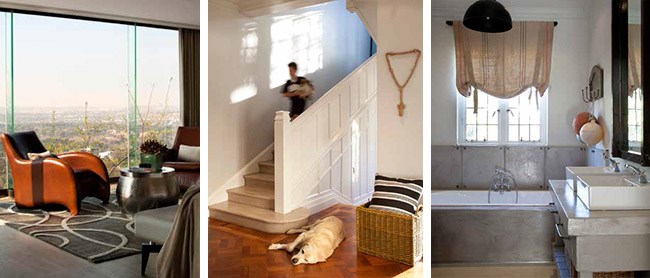
Often homes have unused areas, such as storerooms or patios that have no real function. ‘When you are selling a property every square metre is reflected in the price, so you have to make the most of every space,’ says Val. This means turning that storage room into a study, putting a table and chairs onto the patio to create an attractive area to sit with a cup of coffee, turning an empty corner into a reading nook.
‘Home-staging is very different from interior decoration in that you have to get straight to the point very quickly and cost-effectively,’ explains Val. While interior decorators would put a personal stamp on a home, the job of a home stager is to neutralise it, taking out the more personal elements so that the widest spectrum of people could imagine themselves living there. ‘We recently staged a small house in a secure complex in Hout Bay that had belonged to an old lady. It was in great condition and could be perfect for a young couple without children or an active retired couple, but the furnishings were very dated and elderly, so it was unlikely to appeal to them. We simplified it, brightened up the rooms and made sure every space was being used. We put a small table, chairs and plants on the back patio outside the master bedroom to create an enticing place to have a morning cup of coffee. The transformation was very cost-effective and the house sold for its asking price within three weeks of being put on the market.’
Empty houses are notoriously difficult to sell. Buyers find it hard to see the potential of a space when it is unfurnished and are more likely to focus on negative aspects and move on to the next property on their viewing list. ‘Home staging is about enticing the buyer so that they are seduced by the lifestyle that the property represents,’ says Carol Harding of Home Staging Studio in Cape Town. ‘Very often the buyer will also want to buy the furnishings used in the staging to get the whole feel and look exactly as they are.’ While she doesn’t feel in the current market that home-staging will necessarily achieve a higher price, in her experience it definitely leads to quicker sales. A recently renovated three-bedroom property in Sea Point had been on the market for five weeks with no offers until Carol staged it with her collection of furnishings. After staging it sold on the first day of showing to the first buyer to view it.
Willy Wales of Space Energy in Johannesburg takes an approach to home-staging that has gained pace over the last five years. ‘It’s not about the furniture; it’s about the objects, the art, the carpets,’ he explains. As a result, he has a personal collection of eclectic pieces, antiques and artworks that he uses to stage empty properties, giving them a classic but eclectic and comfortable look that has proved very popular. ‘I’ve been collecting the stuff for the past 30 years. I love curiosities – for those, I head straight for Paris to St Germain and the little shops opposite the Louvre. And Brussels, London, New York – all of them have great markets where I have built up my collectables. I just buy what I love!’ he says, agreeing that it’s a far cry from the early life he lived in the Free State where he grew up on a farm.
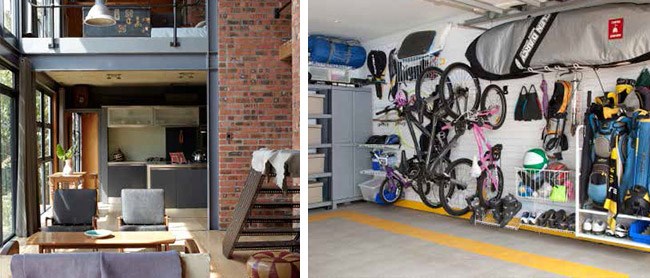
‘I guess I like nice things, and one the thing led to another, and before I knew it, I had done my first house.’ Many of his properties are high-end builds newly completed by developers and so are pristine but empty spaces that buyers find hard to visualise as a home. ‘I take an empty shell and make it look as if it should be on the cover of an Architectural Digest,’ says Willy. ‘Three of my properties have been in Habitat, two on Top Billing. It’s all about taking an empty space and adding glamour and intrigue, making it a place to enjoy.
According to Willy, a property that has been staged tends to sell for between 10% and 15% more than an empty one, and what is more, it sells quickly, often within days of being put on the market. One property transformed by Willy in Parktown North had been on the market for 14 months, with the highest offer achieved in that time being R4,4 million. After staging, it sold on the first show day for R5,5 million. With results like these, the fees charged for his home- staging services (from R30 000 to R100 000 per month depending on the size of the property) are an investment that really does pay dividends.
So is home-staging only accessible for high-end properties of R3 million or more? With a typical budget of around R30 000 or more for a full home-staging service, it does tend to be properties in the higher price bracket that take advantage of it. And while it is accepted in the United States that a seller will spend about 1% of the asking price on home-staging and few properties are sold without it, in South Africa many people are reluctant to spend money on a house they are leaving.
The alternative if you want to increase your chances of a quick sale is to do the staging yourself. One of the problems of doing your own staging is that you are emotionally attached to your home.
Carol advises sellers to try to be detached. ‘View your property as a valuable commodity that you are selling for the best price you can. Forget the emotion.’ Only then can you see problem areas clearly and fix them. She advises that you pack up everything you are not using to get rid of clutter and then consult a home-stager for a professional perspective. Tonya also adds, ‘Do those little handyman jobs that you’ve put off for twenty years, because they won’t be lost on the potential buyers who immediately feel that “their” home has been nourished and loved.’
Most home-staging professionals offer a consultancy session for in the region of R1 500, where they will visit your home, spend one to two hours making recommendations and give you a full report, so you can project-manage the work yourself. You get the benefit of an objective point of view and professional expertise that focuses on the best things to do for maximum effect. They can save you from wasting money on refurbs that won’t make much difference and direct you to things that will be more cost-effective and really add value. Val of Design Boost advises her clients to ‘only let me come to you if really will follow our suggestions and do the work to follow through’. She focuses on the bigger picture, and to get results sellers should follow the advice to the letter, rather than picking and choosing the easiest items on the list. Above all bear in mind that it is the buyer’s emotional response that usually determines a quick sale. Win prospective buyers’ hearts by evoking the feeling of a childhood holiday home, by capturing the feel of a clean, uncluttered lifestyle that they could just walk into by buying your property, create an irresistible picture of what their life could be like living in this home, and sellers will find that they are that many steps closer to closing a sale in record time.
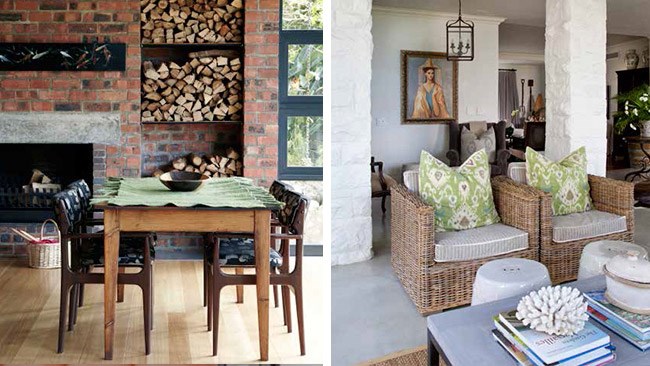
1. Declutter
Most homes are cluttered with too much stuff so that rooms are crowded and feel smaller. Getting rid of your excess possessions, not only helps you sell your home, but also makes your move easier once you do sell. Don’t just pack away your clutter and put it in storage, which only takes your problem on to your next home. Instead, take the opportunity to get rid of it for good. Dispose of, donate or recycle as you go.
2. Depersonalise
The idea of staging a home is to make it appeal to as many people as possible. It isn’t your home and personal taste that you are showing but a property. So take down all but a few family photos, put away collections and quirky decor items, and make the space as neutral as possible, so that others can imagine themselves in your space.
3. Clean
This point should be top of the list. If micro-cleaning isn’t your thing, then hire a cleaning service to spring clean your whole house. Have rugs and curtains cleaned, clean all your appliances, keep the bathroom spotless and the windows shiny, so that everything is at its very best.
4. Fix
Fix that dripping tap, broken doorknob or the closet door that won’t shut… Make all the minor and inexpensive repairs that you can before showing the house. Small defects distract a potential buyer from the positives and make them think there are likely to be larger problems hidden away.
5. Light
Good lighting is the secret of making a house look spacious. Check for dark corners and badly lit areas, and add lamps, put spotlights on artworks and replace dim bulbs with brighter ones.
6. Paint
A fresh coat of paint in a dark room or dingy hallway could make all the difference and is the most affordable way to brighten up the decor. Avoid using bright colours or plain white. Go for classic neutrals that are contemporary and will appeal to more people.
7. Storage
When you are cleaning your home for a dinner party it’s easy enough to tidy everything into a cupboard and close the door. When you are showing your home, people will want to look at storage. Make sure that you have cleaned out cupboards and that they look neat and spacious. The same goes for your garage and any other storage areas. If necessary, hire space in a storage facility to keep all your extra possessions until you move.
8. Shop
Sometimes buying just a few new accessories will be enough to give your home a fresh contemporary look. Think of new cushions, new rugs or throws, new towels, all of which you will be able to take with you when you move.
9. Style
Style your home for show day. The obvious touches are fresh flowers and bowls of fruit, but also think of putting out fresh soaps in bathrooms and rolling towels as they do in hotels to add a touch of class.
10. Garden
Make sure your front garden is tidy and well maintained, as this is the first thing that buyers will see. Trim bushes, mulch flower beds, mow lawns and plant up pots with bedding plants for a spot of colour. Spruce up the pavement outside the house and make sure the gate and driveway are looking immaculate. Give your wheelie- bin a thorough clean and roll it out of sight.
